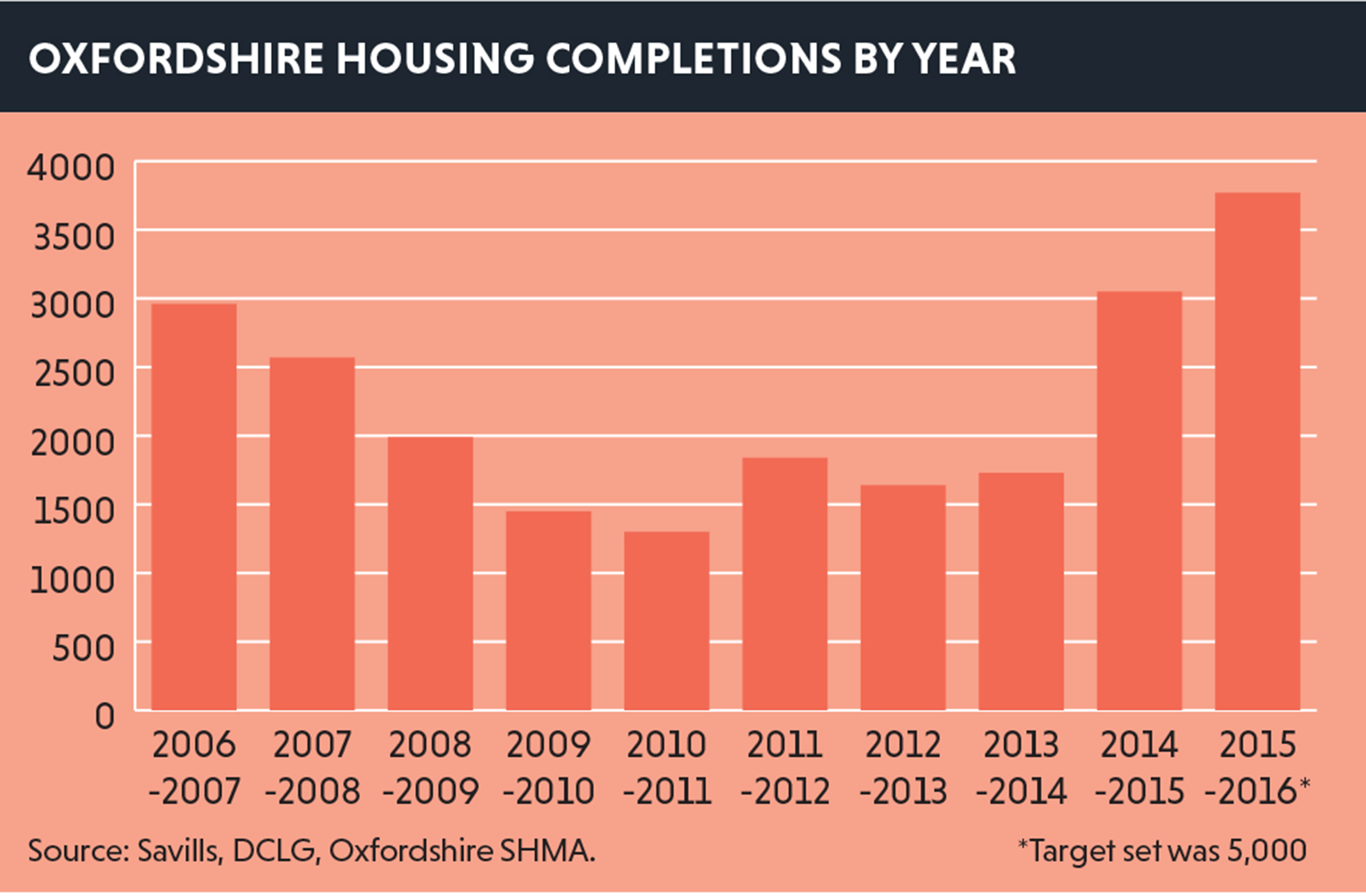Believe it or not, London is not the least-affordable city in the UK. This rather dubious accolade goes instead to Oxford. Research published in March by Lloyds Bank showed that the average house price there was £385,372. That’s a whopping 10.7 times more than annual gross average earnings in the city.
Why is this a particular problem? Commentators warn that Oxfordshire’s thriving economy – based around the business and science parks in the south of the county, as well as the multiple employment generators in Oxford itself – is at risk as employees find themselves priced out of the local housing market.
The answer – build more houses – has been largely accepted by Oxfordshire’s five local authorities, though disagreements over individual housing allocations remain. So the biggest problem facing the county is how to speed up delivery.
A new research report from Savills, revealed exclusively to EG, shows that while housebuilding has risen steadily since 2012, the county is some way off achieving a target of 5,000 annual home completions set in 2015 (see below).
“Although housing delivery in Oxfordshire increased by 24% last year, it was 25% short of requirements,” says Patrick Eve, director at Savills’ Oxford office. “In Oxford, 370 new homes were built, the most since 2008/09.”
The firm’s research report, Is the future bright for Oxford?, includes solutions for delivering more housing throughout the county. These, together with some other suggestions, are explored further below. What is clear is that there is no single quick fix.
Possible solutions
Increased height and/or density
The debate that is already well advanced in London has barely begun in Oxfordshire. It could well be a rude awakening for the dreaming spires of central Oxford, though the view cones around the famous university buildings are likely to be fiercely protected. The first test will come at the end of this month, when Oxford City Council puts policy options out for public consultation that include increases to both height and density.
“There are parts of Oxford that would be suitable for higher densities and some areas where height is very sensitive,” says Patsy Dell, head of planning and regulatory services at the council.
Responses to the consultation period will govern which policies are included in the revision to the city’s local plan.
The outline policies do not specify target density ratios or heights, but Ashley Osborne, head of UK residential at Colliers International, says: “I can certainly see eight storeys as economically viable – it’s just a question of whether that is publicly acceptable.”
Even if increased densities and/or heights are approved in central Oxford, it is likely to be early into the next decade before the first developments complete.
Devolution
There is long-standing political tension between Labour-dominated Oxford City Council and the four other Conservative-dominated local authorities. In addition, there is friction between the five local councils and the county council, which has increased since the beginning of this year when the county published plans for a single-tier county-wide authority.
Would a change in structure help speed up housing delivery? “I think a unitary authority would lead to better progress,” says David Jackson, Savills’ national head of planning.
Tim Burden, director at planning consultancy Turley, agrees, and also points to Cambridgeshire, where last month’s creation of an elected mayor is likely to result in a strategic focus on housing in that county. While there has been no large appetite for an elected mayor in Oxfordshire, the extra clout at central government level would certainly benefit housing delivery. “Long-term changes to governance could be key,” says Burden.

Collaborative working
Both private-sector and public-sector housing professionals agree that large developments are most likely to deliver a significant volume of new homes, but these schemes are also the most vulnerable to delays.
“We think collaboration is key to building these larger developments. Private developers and housing associations can work together to form partnerships that speed up delivery and meet local needs,” says Amanda Williams, group development director at ethical developer Aster Group, which has 140 homes under construction at Great Western Park, Didcot, with a further 260 houses in the pipeline across Oxfordshire.
She explains: “Working together, many housing providers are capable of offering the balance sheet strength to support building a large development in a single push, rather than in small stages. Reducing the financial risk by pooling resources increases the attraction of big schemes to developers.”
Barton Willmore associate Carolyn Organ adds that local authorities could also work more collaboratively. She says: “This could potentially mean that the LEP and the Oxfordshire Growth Board take on a problem-solving role to help schemes come forward and deliver. This isn’t just about funding, but about brokerage between parties and a co-ordination role to smooth the path for delivery.”
Infrastructure improvements
Major new infrastructure projects such as the proposed East-West rail link between Oxford and Cambridge could open up new areas for housing, but they need to be co-ordinated at a strategic level, notes Roger Smith, planning director at Savills’ Oxford office. He says: “There is a long-standing proposal for a new railway station at the planned Grove Airfield (Vale of White Horse) development site – and a decade on we are no nearer to that happening. There needs to be better correlation between infrastructure delivery and housing delivery.”
Planning changes
Though not exclusively an Oxfordshire problem, reform of planning processes would undoubtedly help with the delivery of more homes. “Planning is a major issue – it’s a nonsensical, non-joined-up process,” comments Paul Silver, managing director of housebuilder Dorchester Living, which is building more than 700 homes at Heyford Park, north Oxfordshire.
He adds: “Within a commercial organisation there is someone at the top to knock heads together – no one is really performing that role within the local authorities.”
Turley director Tim Burden notes that some local authorities may challenge housing applications unnecessarily. He points to West Oxfordshire, which has lost 11 successive appeals. “Should the planning system be more punitive?” he asks.
The cost of introducing faster delivery mechanisms, such as the county-led Oxfordshire Growth Board, may be less democratic engagement, observes Savills planning director Roger Smith. He says: “If you go for a process to speed up delivery, there will be less appetite for local involvement.”
Green belt review
Some commentators suggest that a review of green belt land will be necessary if Oxfordshire is to fully deliver its target for new homes. But not everyone agrees. The Campaign to Protect Rural England’s Oxfordshire arm has been vociferous at local planning inquiries as it believes proposed housing numbers are unrealistic and unviable.
Protect Rural Oxfordshire campaign manager Dr Helena Whall says: “We are fearful that the high housing targets will leave local communities at risk of speculative development because councils will not be able to deliver on their five-year housing land supply. The result will be more and more inappropriate development on greenfield sites and designated landscapes.”
More diverse supplier base
New small housebuilders are replacing those that went to the wall during the global downturn, though they may not be getting the opportunities they should, suggests Barton Willmore’s Organ. “One of Oxfordshire’s big problems is that growth is largely in the hands of a small number of housebuilders – there is a lack of diversity, which means a weakness when it comes to delivery. To broaden the base, councils should come together and have a more open dialogue,” she says. “By understanding better which sites are dependent on which housebuilders – and which housebuilders are under-represented – they could be more proactive and joined-up about attracting new housebuilders.”











